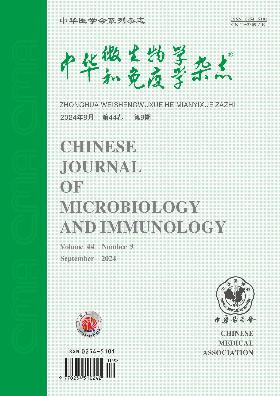Genetic characteristics of coxsackievirus A16 isolated in Shenzhen from 2016 to 2017
Q4 Immunology and Microbiology
引用次数: 0
Abstract
Objective To investigate the genetic characteristics of VP1 genes carried by coxsackievirus A16 strains isolated from cases of hand foot and mouth disease (HFMD) in Shenzhen during 2016 to 2017. Methods Fecal and anal swab specimens were collected from patients with mild HFMD in four sentinel hospitals and the Institute of Pathogen Biology, Shenzhen Center for Disease Control and Prevention, China during 2016 to 2017. All specimens were tested for CVA16 viral RNA using real-time RT-PCR. The VP1 genes of 51 randomly selected CVA16 strains were amplified by RT-PCR and then sequenced using TaKaRa Biomedical Technology (Dalian). Bioinformatics software, including Mega6.02, BioEdit and DNAStar, was used for comparison and analysis of the VP1 genes. Results CVA16 strains in Shenzhen during 2016 to 2017 mainly belonged to B1a and B1b subtypes as well as an emerging subtype B3. The epidemic of B1b subtype was found in both 2016 (28 strains) and 2017 (19 strains), while the B1a subtype (two strains) was only detected in 2017. Two B3 subtype strains were detected in 2017. The strains of B1b subtype were closely related to the strains isolated in Shanghai (JQ314149), Wenzhou (KP289416) and Beijing (KU254598), while the B1a subtype strains were closely related to the strains isolated in Kunming (JQ316639) and Tailand (GQ184139). The B3 subtype strain was an emerging CVA16 epidemic strain in mainland China. Further comparison of the CVA16 epidemic strains in Shenzhen area during 2016 to 2017 with the CVA16 strains causing severe neurological symptoms showed that two amino acid mutations (S14N and M23L) were found in VP1 protein. Conclusions The epidemic strains of CVA16 were B1b subtype in Shenzhen area in 2016. However, B1a, B1b and the emerging B3 subtype strains were prevalent in 2017. Compared with the CVA16 strains causing severe neurological symptoms, the CVA16 strains circulating in Shenzhen during 2016 to 2017 carried two amino acid mutations inVP1 protein. Key words: Coxsackievirus A16; Hand, foot and mouth disease; Phylogenetic analysis2016~2017年深圳分离的柯萨奇病毒A16的遗传特征
目的了解2016~2017年深圳地区手足口病(HFMD)患者分离的柯萨奇病毒A16株携带VP1基因的遗传特征。方法2016年至2017年,从四家定点医院和深圳市疾病预防控制中心病原生物研究所的轻度手足口病患者身上采集粪便和肛门拭子标本。使用实时RT-PCR检测所有标本的CVA16病毒RNA。通过RT-PCR扩增51株随机选择的CVA16菌株的VP1基因,然后使用TaKaRa生物医学技术(大连)对其进行测序。生物信息学软件,包括Mega6.02、BioEdit和DNAStar,用于VP1基因的比较和分析。结果2016~2017年深圳地区CVA16毒株主要属于B1a、B1b亚型和一个新出现的B3亚型。B1b亚型的流行在2016年(28株)和2017年(19株)都有发现,而B1a亚型(2株)仅在2017年才被发现。2017年检测到两株B3亚型菌株。B1b亚型菌株与上海(JQ314149)、温州(KP289416)和北京(KU254598)分离的菌株密切相关,而B1a亚型菌株则与昆明(JQ316639)和泰国(GQ184139)分离的毒株密切相关。B3亚型是中国大陆新出现的CVA16流行株。进一步比较2016年至2017年深圳地区流行的CVA16毒株与引起严重神经系统症状的CVA15毒株,发现VP1蛋白中存在两个氨基酸突变(S14N和M23L)。结论2016年深圳地区CVA16流行株为B1b亚型。然而,B1a、B1b和新出现的B3亚型菌株在2017年流行。与引起严重神经系统症状的CVA16菌株相比,2016年至2017年在深圳流通的CVA116菌株携带VP1蛋白的两个氨基酸突变。关键词:柯萨奇病毒A16;手足口病;系统发育分析
本文章由计算机程序翻译,如有差异,请以英文原文为准。
求助全文
约1分钟内获得全文
求助全文
来源期刊

中华微生物学和免疫学杂志
Immunology and Microbiology-Virology
CiteScore
0.50
自引率
0.00%
发文量
6906
期刊介绍:
Chinese Journal of Microbiology and Immunology established in 1981. It is one of the series of journal sponsored by Chinese Medical Association. The aim of this journal is to spread and exchange the scientific achievements and practical experience in order to promote the development of medical microbiology and immunology. Its main contents comprise academic thesis, brief reports, reviews, summaries, news of meetings, book reviews and trends of home and abroad in this field. The distinguishing feature of the journal is to give the priority to the reports on the research of basic theory, and take account of the reports on clinical and practical skills.
 求助内容:
求助内容: 应助结果提醒方式:
应助结果提醒方式:


